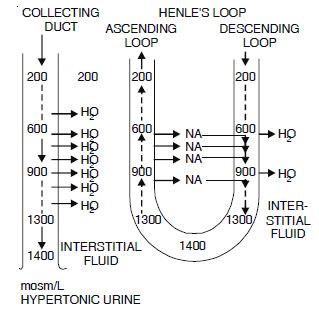Students of Class 11 can avail free NCERT Solutions to enhance their overall performance. These solutions are designed in accordance with the latest CBSE syllabus and make sure to include crucial concepts so that students do not miss out on anything important. NCERT Solutions for Class 11, prepared by experts, makes the learning process an effective and efficient one.
Biology Class 11 chapter “Excretory Products and their Elimination” includes an explanation of concepts like the human excretory system, regulation of kidney function, urine formation, modes of excretion, the role of other organs in excretion, kidney transplant, micturition, function of the tubules, disorders of the excretory system, mechanism of concentration of the filtrate, etc.
Question 1:
Define Glomerular Filtration Rate (GFR).
Answer:
The amount of glomerular filtrate formed by the kidneys per minute is called glomerular filtration rate. The value of GFR in a healthy individual is around 125 ml/minute, i.e., 180 litres per day.
Structure of Juxta glomerular apparatus.
Question 2:
Explain the autoregulatory mechanism of GFR.
Answer:
The kidneys have an inbuilt mechanism for the regulation of GFR by Juxta Glomerular Apparatus (JGA). At the point of contact of distal convoluted tubule and the afferent arteriole, are present swollen, dark coloured cells which have renin. Renin converts angioten-sinogen in blood to angiotensin I and further to angiotensin II which is a powerful vaso-constrictor. This increases glomerular blood pressure and thereby GFR.
Question 3:
Micturition is carried out by a reflex.
Answer:
TRUE
Question 4:
ADH helps in water elimination, making the urine hypotonic.
Answer:
FALSE
Question 5:
Protein free fluid is filtered from blood plasma into the Bowman’s capsule.
Answer:
TRUE
Question 6:
Henle’s loop plays an important role in concentrating the urine.
Answer:
TRUE
Question 7:
Glucose is actively reabsorbed in the proximal convoluted tubule.
Answer:
TRUE
Question 8:
Give a brief account of the counter current mechanism.
Answer:
Role of counter current mechanism.
(i) Sodium is actively transported from the ascending limb of the loop of Henle to the interstitial tissue and thus increasing its concentration there. Some amount of Na+ from the interstitial tissue diffuse into descending limb.
(ii) The increase in the osmolarity of the interstitial tissue due to sodium pump causes some water to leave the descending limb by passive diffusion. This makes the urine increasingly hypertonic in descending limb and vice-versa in ascending limb.
Question 9:
Describe the role of liver, lungs and skin in excretion.
Answer:
Role of liver. Liver is a multi-purpose largest gland of the vertebrates. It helps in excretion in the following ways :
(a) Formation of bile pigments (bilirubin and biliverdin) and urine pigment (urochrome) from the haemoglobin of dead RBCs.
(b) Changing the excessive and harmful amino acids into urea by deamination and detoxification through urea or ornithine cycle.
(c) Excretion of cholesterol, inactivated products of steroid hormones, certain vitamins (e.g., vitamin C) and many toxic drugs.
Role of lungs in excretion. Human lungs excrete about 18 L of CO2 per hour and about 400 ml of water per day formed as a result of carbohydrate metabolism. Other volatile substances are also eliminated through lungs.
Role of skin in excretion. (i) In most of the aquatic animals ammonia is excreted into aqueous medium by diffusion.
(ii) Human skin excretes sweat from sweat glands and sebum from sebaceous gland. Sweat is aqueous fluid containing water (99.5%) and NaCl, lactic acid, urea, amino acids and glucose. Volume of fixed ranges from negligible to 14 L a day. Sebum is a waxy secretion which eliminates waxes, sterols, other hydrocarbons and fatty acids.
Question 10:
Explain Micturition.
Answer:
The expulsion of urine from the urinary bladder is called micturition. It is carried out by a reflex.
Question 11:
Match the following:
- Ammonotelism
- Bowman’s capsule
- Micturition
- Uricotelism
Answer:
1. (c), 2. (b), 3. (d), 4. (a)
Question 12:
What is meant by the term osmoregulation ?
Answer:
Osmoregulation is a process that regulates body’s water and salt concentration. Different animals have the capacity to adjust themselves in different salt concentration of water. The kidneys help in maintaining osmoregulation in mammals by excreting either hypotonic or hypertonic urine depending upon the availability of water and salt in the blood.
Question 13:
Terrestrial animals are generally either ureotelic or uricotelic, not ammonotelic. Why ?
Answer:
The excretion of ammonia requires a large quantity of water loss whereas urea in uric acid require negligible amount of water for their excretion. Since terrestrial animals need to conserve body water, so they opt for the excretory product so as to lose less quantity of water. Therefore they are mostly ureotelic or uricotelic.
Question 14:
What is the significance of juxta glomerular apparatus (JGA) in kidney function ?
Answer:
JGA secretes Renin which functions to increase glomerular blood pressure and glomerular filtration rate.
Question 15:
Name the following :
- A chordate animal having flame cells as excretory structures.
- Cortical portions projecting between the medullary pyramids in the human kidney.
- A loop of capillary running parallel to the Henle’s loop.
Answer:
(a) Amphioxus, (b) Columns of Bertini, (c) Vasa recta.
Question 16:
Ascending limb of Henle’s loop is .................... to water whereas the descending limb is .............. to it.
Answer:
impermeable, permeable
Question 17:
Reabsorption of water from distal parts of the tubules is facilitated by ............. hormone.
Answer:
Anti- diuretic
Question 18:
Dialysis fluid contain all the consti- tuents as in plasma except ................. .
Answer:
nitrogenous wastes
Question 19:
A healthy adult human excretes (on an average) .......... gm of urea/day.
Answer:
25-30


